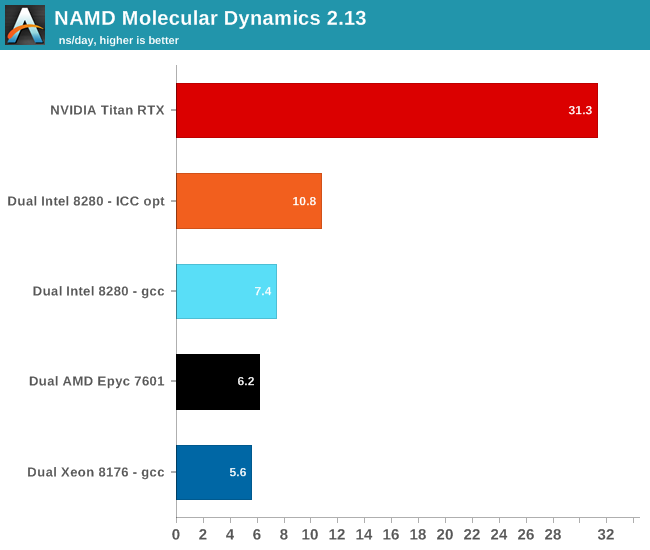Intel's Xeon Cascade Lake vs. NVIDIA Turing: An Analysis in AI
by Johan De Gelas on July 29, 2019 8:30 AM ESTExploring Parallel HPC
HPC benchmarking, just like server software benchmarking, requires a lot of research. We are definitely not HPC experts, so we will limit ourselves to one HPC benchmark.
Developed by the Theoretical and Computational Biophysics Group at the University of Illinois Urbana-Champaign, NAMD is a set of parallel molecular dynamics codes for extreme parallelization on thousands of cores. NAMD is also part of SPEC CPU2006 FP.
To be fair, NAMD is mostly single precision. And, as you probably know, the Titan RTX was designed to excel at single precision workloads; so the NAMD benchmark is a good match for the Titan RTX. Especially now that the NAMD authors reveal that:
Performance is markedly improved when running on Pascal (P100) or newer CUDA-capable GPUs.
Still, it is an interesting benchmark as the NAMD binary is compiled with Intel ICC and optimized for AVX. For our testing, we used the "NAMD_2.13_Linux-x86_64-multicore" binary. This binary supports AVX instructions, but only the "special” AVX-512 instructions for the Intel Xeon Phi. Therefore, we also compiled an AVX-512 ICC optimized binary. This way we can really measure how well the AVX-512 crunching power of the Xeon compares to NVIDIA’s GPU acceleration.
We used the most popular benchmark load, apoa1 (Apolipoprotein A1). The results are expressed in simulated nanoseconds per wall-clock day. We measure at 500 steps.

Using AVX-512 boosts performance in this benchmark by 46%. But again, this software runs so much faster on a GPU, which is of course understandable. At best, the Xeon has 28 cores running at 2.3 GHz. Each cycle 32 single precision floating operations can be done. All in all, the Xeon can do 2 TFLOPs (2.3 G*28*32). So a dual Xeon setup can do 4 TFLOPs at the most. The Titan RTX, on the other hand, can do 16 TFLOPs, or 4 times as much. The end result is that NAMD runs 3 times faster on the Titan than on the dual Intel Xeon.










56 Comments
View All Comments
Bp_968 - Tuesday, July 30, 2019 - link
Oh no, not 8 million, 8 *billion* (for the 8180 xeon), and 19.2 *billion* for the last gen AMD 32 core epyc! I don't think they have released much info on the new epyc yet buy its safe to assume its going to be 36-40 billion! (I dont know how many transistors are used in the I/O controller).And like you said, the connections are crazy! The xeon has a 5903 BGA connection so it doesn't even socket, its soldered to the board.
ozzuneoj86 - Sunday, August 4, 2019 - link
Doh! Thanks for correcting the typo!Yes, 8 BILLION... it's incredible! It's even more difficult to fathom that these things, with billions of "things" in such a small area are nowhere near as complex or versatile as a similarly sized living organism.
s.yu - Sunday, August 4, 2019 - link
Well the current magnetic storage is far from the storage density of DNA, in this sense.FunBunny2 - Monday, July 29, 2019 - link
"As a single SQL query is nowhere near as parallel as Neural Networks – in many cases they are 100% sequential "hogwash. SQL, or rather the RM which it purports to implement, is embarrassingly parallel; these are set operations which care not a fig for order. the folks who write SQL engines, OTOH, are still stuck in C land. with SSD seq processing so much faster than HDD, app developers are reverting to 60s tape processing methods. good for them.
bobhumplick - Tuesday, July 30, 2019 - link
so cpus will become more gpu like and gpus will become more cpu like. you got your avx in my cuda core. no, you got your cuda core in my avx......mmmmmmbobhumplick - Tuesday, July 30, 2019 - link
intel need to get those gpus out quickAmiba Gelos - Tuesday, July 30, 2019 - link
LSTM in 2019?At least try GRU or transformer instead.
LSTM is notorious for its non-parallelizablity, skewing the result toward cpu.
Rudde - Tuesday, July 30, 2019 - link
I believe that's why they benchmarked LSTM. They benchmarked gpu stronghold CNNs to show great gpu performance and benchmarked LSTM to show great cpu performance.Amiba Gelos - Tuesday, July 30, 2019 - link
Recommendation pipeline already demonstrates the necessity of good cpus for ML.Imho benching LSTM to showcase cpu perf is misleading. It is slow, performing equally or worse than alts, and got replaced by transformer and cnn in NMT and NLP.
Heck why not wavenet? That's real world app.
I bet cpu would perform even "better" lol.
facetimeforpcappp - Tuesday, July 30, 2019 - link
A welcome will show up on their screen which they have to acknowledge to make a call.So there you go; Mac to PC, PC to iPhone, iPad to PC or PC to iPod, the alternatives are various, you need to pick one that suits your needs. Facetime has magnificent video calling quality than other best video calling applications.
https://facetimeforpcapp.com/